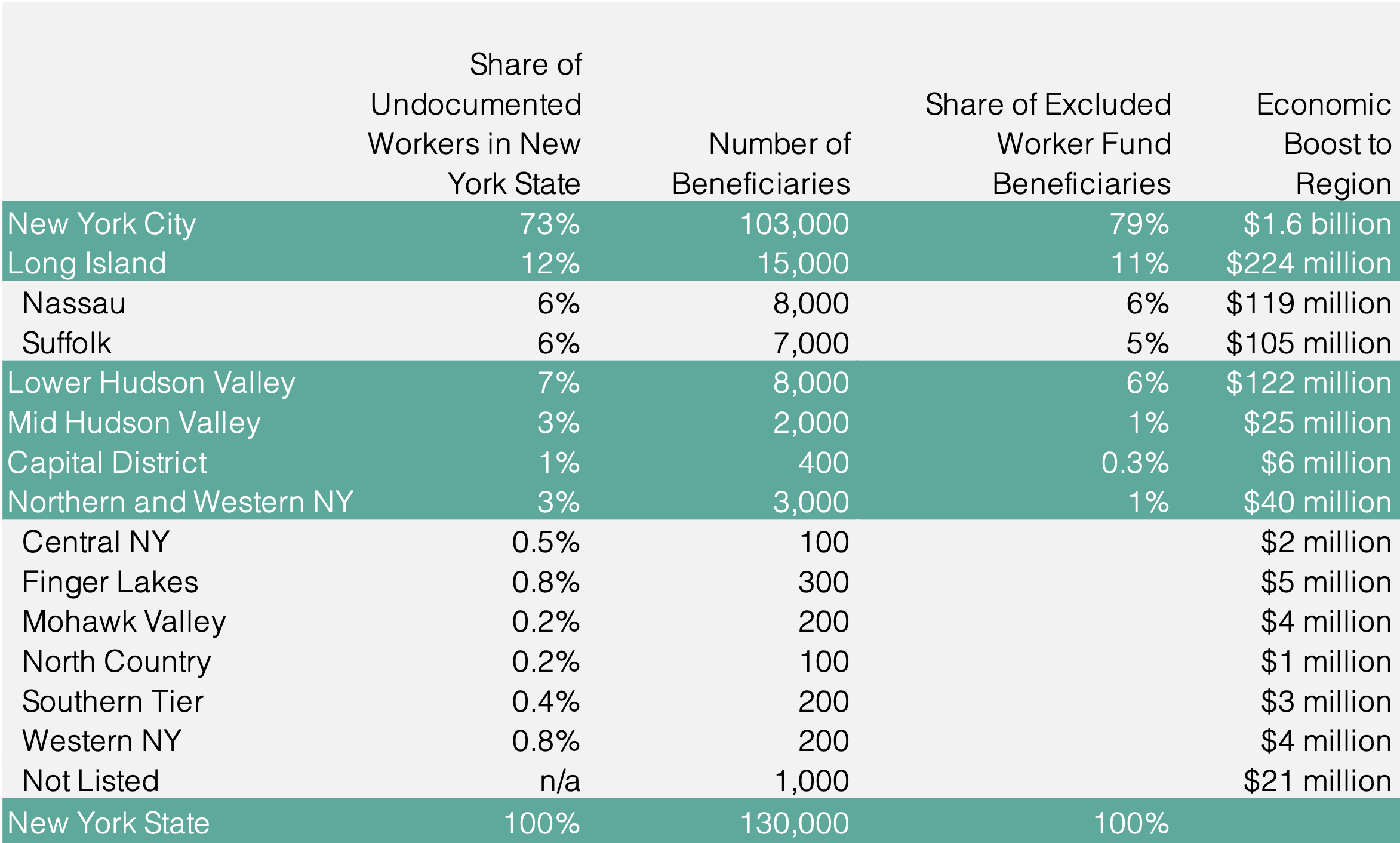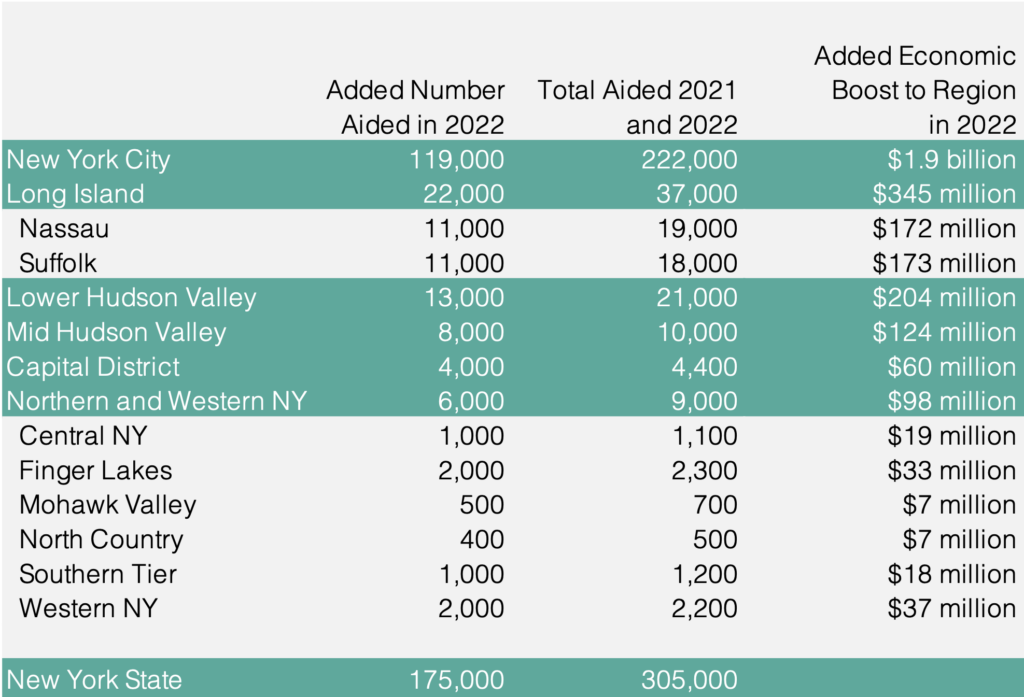Excluded Worker Fund: Crucial Support, But More Is Needed
Through the depths of the withering Covid recession, regular Unemployment Insurance and emergency Pandemic Unemployment Assistance provided crucial income support for most people who lost their jobs. But they left a significant gap: undocumented workers, who were hit especially hard by the pandemic, were not eligible for either.
In New York State a landmark $2.1 billion Excluded Worker Fund extended unemployment compensation to workers who were not eligible for Unemployment Insurance or pandemic-related income relief, primarily undocumented immigrants.
The Excluded Worker Fund was quickly stood up, and the state Department of Labor began to accept applications in August 2021. However, just nine weeks later the fund was depleted. That is a testament to the Department of Labor’s success in getting money quickly to workers who lost income. But it is also evidence that more funds are urgently needed.
This report shows a regional breakdown for the 130,000 workers who received unemployment compensation in 2021. It shows how expanding the fund by $3 billion in 2022, as proposed by the Fund Excluded Workers Coalition, would enable an additional 175,000 workers who qualify to receive the support. And, it shows how this additional funding would at the same time correct a regional imbalance in the fund’s distribution.
$2.1 Billion Aided 130,000 Workers in 2021
A near-final tabulation of the fund’s expenditures shows substantial benefits to every region of New York State. In total, just over $2 billion was paid to over 130,000 workers, with administrative costs coming in under the budgeted 10 percent of the fund. Nearly all (over 99 percent) workers who received funds got $15,600, an amount on a par with what others received in unemployment benefits.
New York City, which has the largest total population and also the largest share of undocumented workers, saw 103,000 beneficiaries. The city economy also gained: since sustaining income for workers also means money spent in the local economy, the program also gave a direct boost of $1.6 billion to help the local economy climb out of a deep recession.
On Long Island, nearly 15,000 workers benefited, with a boost to the local economy of $224 million. In the Lower Hudson Valley (Putnam, Rockland, and Westchester counties), 8,000 workers benefited with an economic boost to the region of $122 million. The Mid-Hudson Valley (Dutchess, Orange, and Sullivan counties) saw 2,000 workers benefit from the fund, with a $25 million direct impact on the local economy. In the Capital District (Albany, Columbia, Greene, Rensselaer, Saratoga, Schenectady, Warren and Washington counties) 400 people benefited with a $6 million impact on the local economy. And in Northern and Western New York, 3,000 people benefited with a boost to the regional economy of $40 million.
When the fund ran out, it left long lists of people in line and many others who had not yet even started the process. Replenishing the fund so that all workers who qualify can benefit is still urgently needed by workers and their families.
Replenishing the fund is also a matter of regional equity. In New York City there is a strong infrastructure of groups helping people apply as well as city government programs to help raise awareness. It is thus perhaps not surprising that New York City is the one region of the state where share of recipients (79 percent of the state total) is higher than the share of undocumented workers (73 percent of all in the state).
On the other hand, because the fund ran out quickly, regions where workers had less help or took longer to apply saw disproportionately fewer fund recipients.
$2.1 Billion In 2021 130,000 Workers Benefit, Though Some Regions Lag

Immigration Research Initiative analysis. Data on beneficiaries provided by the New York State Department of Labor, adjusted to match most recent public data on total number of recipients and total funds allocated. Data on undocumented immigrants in areas highlighted in blue provided by the Center for Migration Studies, based on imputations into the 2018 American Community Survey data, with the regions in grey further imputed based on the 2019 American Community Survey 5-year data for non-citizens in the region. Total recipients rounded to nearest 10,000; regions rounded to nearest 1,000 or to nearest 100 where total is under 1,000.
On Long Island, in the Hudson Valley, and across upstate New York the share of beneficiaries was consistently smaller than the share of undocumented workers in the region. The state allocated funding to nonprofit groups to help offset this challenge and ensure that everyone who qualified could apply, but in many cases the organizations were just getting started in helping applicants when the funds ran out.
Long Island, home to 12 percent of the state’s undocumented workers, saw 11 percent of the 2021’s beneficiaries. The Lower Hudson Valley is home to seven percent of the state’s undocumented immigrants and saw six percent of the beneficiaries. All other regions—Mid Hudson Valley, Capital District, and Northern and Western New York—saw roughly a third as many recipients as the share of undocumented workers.
$3 Billion Will Aid an Additional 175,000 in 2022
The Fund Excluded Worker coalition has called for adding $3 billion to the Excluded Worker Fund to ensure that people who qualify are not denied support simply because they were not fast enough to apply before last year’s funds were exhausted. Immigration Research Initiative estimates that an added $3 billion would allow the state to reach an additional 175,000 workers who experienced loss of work between February 2020 and April 2021 would be able to receive benefits. This analysis assumes a 10 percent cost for administration and outreach, as was written into the excluded Worker Fund legislation of 2021.
Replenishing the funds would also allow for regions where it took workers a little longer to apply for the unemployment compensation to catch up. The analysis in the table below assumes that the overall final number of fund recipients in each region are proportionate to the number of undocumented workers who live there, and that where that was under- represented in 2021 it is equalized by replenished funds in 2022.
$3 Billion In 2022 175,000 Added Workers Benefit, Equity Across Regions

Immigration Research Initiative analysis. Number of recipients assumes same share of undocumented in each region receive benefits, with regions lagging in 2021 making up the difference in 2022. Assumes nearly all recipients qualify for Tier 1 benefits, as has been the case in 2021. 2022 regional number aided rounded to nearest 1.000 or to nearest 100 where total is under 1,000.
On Long Island, an additional 22,000 people who lost work and were excluded from other unemployment benefits would receive Excluded Worker Fund benefits with a total direct economic boost to the region of $345 million. In the Lower Hudson Valley it would mean an additional 13,000 workers benefiting and $204 million economic boost, in the Mid-Hudson Valley 8,000 workers and $124 million in economic boost, in the Capital District 4,000 workers and $60 million in economic boost, and in Northern and Western New York 6,000 workers and $98 million in economic boost.
This updates a report first published on January 24, 2022 and was updated on March 13, 2022.